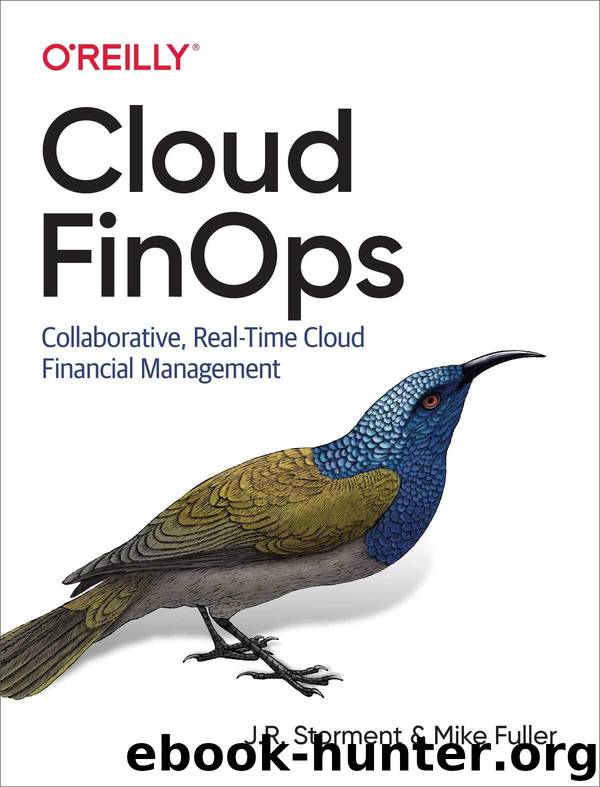Cloud FinOps by Storment J. R. Fuller Mike

Author:Storment, J. R. Fuller, Mike
Language: eng
Format: epub
Publisher: epubor.com
Serverless Computing
Serverless computing is a model in which the cloud provider runs the server and dynamically manages the allocation of machine resources. Pricing is based on actual functions performed rather than on prepurchased units of capacity.
It removes many of the unused or underutilized issues discussed earlier in this chapter. With serverless, you truly pay only for what you’re actively using. And unused resources aren’t typically easy to leave lying around. Serverless architectures can usually be ready to process requests very quickly, compared to starting new server instances and deploying your software when needed.
But the move to serverless isn’t without cost, and it’s by no means a panacea to the wastage problem. There was recently a healthy debate within the FinOps Foundation on the best way to forecast and compare the serverless costs for an application versus its current compute-heavy architecture. Several exceptional methods were suggested, and in the end the discussion showed how much the practice is still evolving.
Ultimately, the complexity of building any migration plan to serverless resides in execution and has very little to do with cost savings. A recommendation to move from a large server instance to many concurrent lambda executions is meaningless, since the cost-associated savings in doing so pale in comparison to the engineering effort to get there. For the majority of cases, there’s little point in worrying about the forecasting or optimizing of serverless, because the real cost is not the cloud bill but the rearchitecting of applications. Put simply: serverless is cheap, but refactoring for serverless is not. Thus, serverless is often a better option for greenfield projects rather than existing applications.
However, there’s an entirely different lens through which you can evaluate serverless: total cost of ownership (TCO), or the cost of the engineering teams that are required to build a solution, and the impact of time to market on the success and profitability of a service. Remember, serverless allows you to delegate a lot of responsibilities to the cloud provider. Duties that DevOps engineers would typically handle (server management, scaling, provisioning, patching, etc.) become the responsibility of AWS, GCP, or Azure, which leaves dev teams free to focus on shipping differentiating features faster.
Too often — even in this book — the focus is on the cost of the infrastructure itself. But the biggest cost in software development is commonly the people. Consider this closely when looking at both sides of the serverless argument. The people cost (e.g., salaries) may cancel out any infrastructure savings when you’re considering a move from a monolithic application to a serverless one. Coming back to the benefits versus effort, you should consider the overall cost in redesigning services for serverless against the potential for reduced costs.
But when you’re building a new greenfield serverless service, the people cost savings may be well worth it. Remember that serverless can both speed up time to market (by preventing you from rebuilding functionality that is available off the shelf) and dramatically reduce ongoing ops requirements. These benefits allow you to redirect resources to building products instead of to maintaining servers.
Download
This site does not store any files on its server. We only index and link to content provided by other sites. Please contact the content providers to delete copyright contents if any and email us, we'll remove relevant links or contents immediately.
Kotlin in Action by Dmitry Jemerov(17250)
Grails in Action by Glen Smith Peter Ledbrook(15436)
Sass and Compass in Action by Wynn Netherland Nathan Weizenbaum Chris Eppstein Brandon Mathis(13293)
Azure Containers Explained by Wesley Haakman & Richard Hooper(7500)
Configuring Windows Server Hybrid Advanced Services Exam Ref AZ-801 by Chris Gill(7497)
Running Windows Containers on AWS by Marcio Morales(7054)
Microsoft 365 Identity and Services Exam Guide MS-100 by Aaron Guilmette(5436)
Microsoft Cybersecurity Architect Exam Ref SC-100 by Dwayne Natwick(5275)
Combating Crime on the Dark Web by Nearchos Nearchou(5018)
The Ruby Workshop by Akshat Paul Peter Philips Dániel Szabó and Cheyne Wallace(4701)
Management Strategies for the Cloud Revolution: How Cloud Computing Is Transforming Business and Why You Can't Afford to Be Left Behind by Charles Babcock(4550)
Python for Security and Networking - Third Edition by José Manuel Ortega(4274)
The Age of Surveillance Capitalism by Shoshana Zuboff(4253)
Learn Wireshark by Lisa Bock(4176)
Learn Windows PowerShell in a Month of Lunches by Don Jones(4073)
The Ultimate Docker Container Book by Schenker Gabriel N.;(3920)
Ember.js in Action by Joachim Haagen Skeie(3670)
DevSecOps in Practice with VMware Tanzu by Parth Pandit & Robert Hardt(3612)
Windows Ransomware Detection and Protection by Marius Sandbu(3579)
